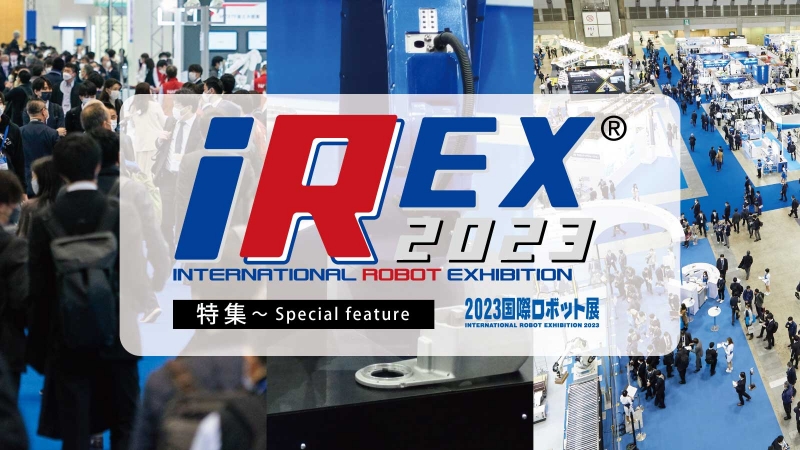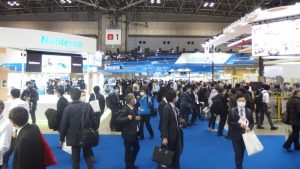
- News
- Basics
- Products
- JP Job shop
- Exhibition
- Interview
- Statistic
- PR
- Download
- Special contents
Exhibition
December 3, 2023


By:Yuya Sone, Staff Editor
Robots will become the infrastructure that supports society – that is no exaggeration. Just as with electricity, water, roads, ports, and communication networks, there will come a time in the future when society cannot function without robots. The electrical infrastructure provides the power, but robots provide the “manpower”. A future in which we use robots as a matter of course, not only in automotive and electrical equipment manufacturers and companies that invest aggressively in automation, but in all workplaces, is becoming more and more real. In the face of unprecedented declining birth rates, aging populations, and labor shortages, who can say that such a future will never come?
Japan’s working-age population aged 15-64 continues to decline, from 87.16 million in 1995 to 75.09 million in 2020, a decrease of more than 10 million. Estimates show that the number of people in this age group continues to decline steadily: 71.7 million in 2025, 68.75 million in 2030, 5.978 million in 2040, and 52.75 million in 2050.
According to the “Labor force survey” conducted by the Ministry of Internal Affairs and Communications in Japan, the number of workers in Japan as a whole has not yet declined sharply because it has been offset by the reemployment of older people and the active participation of women. However, the total number of workers is expected to decline in the future as more elderly people enter full retirement.
The current labor shortage is already severe, but there is no doubt that it will worsen in the future. While it is important to strengthen human resource recruitment, automation is also an urgent issue to ensure business continuity with fewer workers.
While there are many ways to automate, much of the attention in recent years has been focused on robots. Conventional automation has focused on how to improve the efficiency of mass production. This is best done with specialized equipment designed for each application. Robots, on the other hand, are “general-purpose automation devices” that can be used to automate various tasks, although they are not as efficient as dedicated devices.
Processes that can be easily automated with dedicated equipment have already been automated, and robots are the key to further increasing the rate of automation. Robots can be used to automate processes that were previously performed manually, such as processes before and after specialized equipment. Robots can also be used as part of a mass production system, but their versatility has led to a gradual increase in their use in low-volume, high-mix production facilities. Developments in sensing and artificial intelligence technologies are driving the use of robots in low-volume, high-mix production.
Statistical data shows that robot installations have increased in recent years. According to the International Federation of Robotics (IFR), the number of industrial robots installed in Japan in 2022 was 50,413, up 9% from the previous year. This is more than the 49,908 units installed in 2019, the year before the pandemic. The number of new robots installed worldwide is also on the rise, increasing by 5% in 2022 compared to the previous year. In addition, it is forecast to grow at a compound annual growth rate of 7% from 2023 to 2026.
Although robot installations are increasing, Japan’s working-age population is declining by about one million, and by about 10 million in the long term. Adding 50,000 new robots per year are not enough. Not everything can be replaced by robots, but there is still a lot of room for growth in robot installations.
 At a time when interest in automation is growing like never before, the International Robot Exhibition 2023 (iREX2023) was held at Tokyo Big Sight in Tokyo from November 29 to December 2. iREX is one of the largest robotics exhibitions in the world. Yasuhiko Hashimoto, President and CEO of Kawasaki Heavy Industries and Chairman of the iREX Steering Committee, said before the event, “This is an event for everyone. Robots are going to become more accessible in the future”.
At a time when interest in automation is growing like never before, the International Robot Exhibition 2023 (iREX2023) was held at Tokyo Big Sight in Tokyo from November 29 to December 2. iREX is one of the largest robotics exhibitions in the world. Yasuhiko Hashimoto, President and CEO of Kawasaki Heavy Industries and Chairman of the iREX Steering Committee, said before the event, “This is an event for everyone. Robots are going to become more accessible in the future”.
SEISANZAI Japan introduces the most advanced robot proposals through each company’s exhibits at the iREX2023. At the exhibition, many companies are focusing on specific applications.
Kiyonori Inaba, Executive Managing Officer, General Manager Robot Business Division, FANUC, commented, “Users’ awareness of automation is growing rapidly. We want to show a variety of robot applications and promote the ease of use of our robots”. Manabu Okahisa, General Manager, Robotics Division, Yaskawa Electric, said, “iREX is not a place to show robots, but to show what robots can do”. Junji Takehara, Chief Engineer of the Robot Manufacturing Department at Mitsubishi Electric’s Nagoya Works, said, “We are proposing an intelligent factory based on the premise that it can handle variable-type and variable-volume production. We want to show that Mitsubishi Electric is more than just robots”. Atsushi Koshino, General Manager of the Development Department of NACHI Robot Division, is enthusiastic about the exhibit, saying, “We plan to show more specific exhibits, with the collaborative robot ‘CMZ05’ as the main exhibit, based on the scenarios in which users use the robot”.
The “With Robots” era, in which the use of robots is a matter of course, has not yet arrived, but it is not too early to start preparing for it.